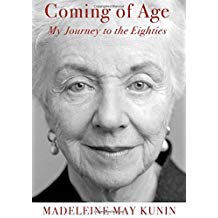Coming of Age: My Journey to the Eighties, Madeleine May Kunin 2018
In her new memoir, Coming of Age: My Journey to the Eighties (Green Writer’s Preess, 2018), Madelaine May Kunin writes with passion, curiosity, intelligence, and beauty about her amazement that she has become old. But what an old lady she is! Beginning with the cover photo, a full-on head shot of a beautiful and aging 84 year old woman, Kunin addresses the reader with unflinching honesty and plain talk. No plastic surgery, no touched up photographs, no avoiding the hard questions and issues, no denial; just honest, curious, intense, funny, unflinching, inquiry and concise and often beautiful writing. This memoir’s primary focus, in Kunin’s words, is to “fulfill a need for self-definition and a wish to make sense of what is happening to me.” Unlike the traditional memoir it only glancingly touches on the objective facts of Kunin’s life as she explores the land of the aging, the new world in which the body begins to fail and the mind deals with ‘short term memory loss creeping up on me like a hungry vine.” Kunin brings a sharp eye, a curious mind, and a wonderful facility with words to this exploration. In chapters on love, sexual attraction, depression, bodily changes (I love her intact vanity when she says “I have gained weight (not too much)”), and the hardware of aging (canes, walkers, and wheelchairs), she dwells on her observations of her own aging process accompanied by those she experiences as her husband, ten years older, previews the coming attractions. Hennessey’s death shortly after she completed the book is a sobering coda to the memoir. Each of the sixteen chapters are preceded by a brief, beautiful poem. In ‘No Longer’, each stanza begins with that refrain, citing things she can’t do anymore. In what could have been a sad, maudlin, or tragic work, she instead finishes the poem with a beautiful and optimistic message:
I want the days to saunter,
like a leisurely
museum stroller who stops
now and then to gaze;
and get closer to the canvas
to see the brush strokes,
and then steps back
for the long view,
before moving on.
And this is what Kunin has done. She has invited us to saunter with her through the museum of her life, full of beautiful experiences and moments. She is not one to feel self-pity, and her view of aging with its intense self-examination and self-awareness is one that should inspire and energize all of us who are lucky enough to have the opportunity to enter our 80’s with a sound mind and sound-enough body. This is a book that warrants reading by all generations—-those aging and those faced with helping their aging parents and friends along the way.



